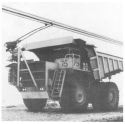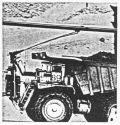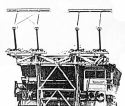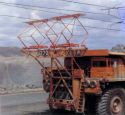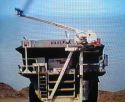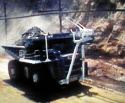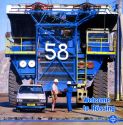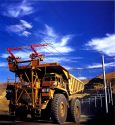History
Deere & Company began when John Deere, born in Rutland, Vermont, USA on February 7, 1804 moved to Grand Detour, Illinois in 1836 to escape bankruptcy in Vermont. Already an established blacksmith, Deere opened a 1,378 square feet shop in Grand Detour in 1837 which allowed him to serve as a general repairman in the village, as well as a manufacturer of small tools such as pitchforks and shovels.
Even more successful than these small tools was Deere's cast-steel plow, which was pioneered in 1837. Prior to Deere's introduction of the steel plow, most farmers used iron or wooden plows which stuck to the rich Midwestern soil and had to be cleaned very frequently. The smooth sided steel plow solved this problem, and would greatly aid migration into the American Great Plains in the 19th century and early 20th century. Deere's production of plows began slowly, but increased greatly when he departed from the traditional business model of making equipment as it was ordered and instead began to manufacture plows before they were ordered and then put them up for sale. This allowed customers to see what they were buying beforehand, and word of the product began to spread quickly.
In 1842, Deere entered a business partnership with Leonard Andrus and purchased land for the construction of a new two-story factory along the Rock River in Illinois. This factory, named the "L. Andrus Plough Manufacturer", produced about 100 plows in 1842 and approximately 400 plows during the next year. Despite the success, Deere's partnership with Andrus ended in 1848, when Deere relocated to Moline, Illinois in order to have access to the railroad and the Mississippi River. In Moline, Deere formed a partnership with Robert Tate and John Gould and quickly built a new 1,440 square feet factory in 1848. Production at the plant rose quickly, and by 1849 the Deere, Tate, & Gould Company was producing over 200 plows a month, and a two story addition to the plant was built to allow for further production.
John Deere bought out Tate and Gould's interests in the company in 1853, the same year that he was joined in the business by his son Charles Deere. The business continued to expand until 1857, when the company's production totals reached almost 1,120 implements per month. Then, in 1858 a nationwide financial recession took a toll on the company. In order to prevent bankruptcy, the company was reorganized and Deere sold his interests in the business to his son in law, Christopher Webber, and his son, Charles Deere, who would take on most of his father's managerial roles. The company was reorganized one final time in 1868, when it was incorporated as Deere & Company. The company's original stockholders were Charles Deere, Stephen Velie, George Vinton, and John Deere, who would serve as president of the company until 1886. Despite this, it was Charles who effectively ran the company. In 1869, Charles began to introduce marketing centers and independent retail dealers to advance the company's sales nationwide.
John Deere died in 1886, and the presidency of Deere & Company passed to Charles Deere. By now the company was manufacturing a variety of farm equipment products in addition to plows, including wagons, corn planters, cultivators. The company even expanded into the bicycle business briefly during the 1890s, but the core focus of the company remained on agricultural implements. Increased competition during the early 1900s from the new International Harvester Company led the company to expand its offerings in the implement business, but it was the production of gasoline tractors which would come to define Deere & Company's operations during the twentieth century.
In 1912, Deere & Company president William Butterworth, who had replaced Charles Deere after his death in 1907, began the company's expansion into the tractor business. Deere & Company briefly experimented with its own tractor models, the most successful of which was the Dain All-Wheel-Drive, but in the end decided to continue its foray into the tractor business by purchasing the Waterloo Gasoline Engine Company, which manufactured the popular Waterloo Boy tractor at its facilities in Waterloo, Iowa. Deere & Company continued to sell tractors under the Waterloo Boy name until 1923, when the John Deere Model D was introduced. The company still manufactures most of its tractors in Waterloo, Iowa.
According to John Ratzenberger, host of the Travel Channel series "Made in America", Deere & Company never repossessed any equipment from American farmers during the Great Depression. This was revealed during the shows profile of Deere & Company.
Deere & Company Today
As of 2006, the Deere & Company employs approximately 47,000 people in 27 countries worldwide, including the United States, Turkey, Canada, United Kingdom, China, France, Germany, Spain, Italy, India, Poland, and Mexico, among many others. Inside the United States, the company's primary locations are its administrative center in Moline, Illinois, as well as various locations in the Midwest and southeastern United States. Most manufacturing sites are in Iowa or Illinois, as well as locations in Europe. Carl Westby is known as the person that coined the phrase "Nothing runs like a Deere."
Major North American factories include:
- Waterloo Works (foundry, engines, large agricultural tractors, drive trains, service parts) Waterloo, Iowa
- Harvester Works(large combine harvesters) East Moline, IL
- Cylinder Division (hydraulic cylinders) Moline, Illinois
- Seeding Group (planting equipment) Moline, Illinois and Valley City, North Dakota
- Davenport Works (wheel loaders, motor graders, articulated dump trucks, forestry equipment) Davenport, Iowa
- Dubuque Works (backhoes, crawlers, skid-steer loaders, forestry equipment) Dubuque, Iowa
- Des Moines Works (tillage equipment, cotton harvesters, sprayers) Ankeny, Iowa
- Ottumwa Works (hay and forage equipment) Ottumwa, Iowa
- John Deere Thibodaux (cane harvesting equipment, scrapers) Thibodaux, Louisiana
- Horicon Works (lawn & garden and turf care) Horicon, Wisconsin
- Augusta Works (small commercial and agricultural tractors) Augusta, Georgia
- Welland Works (agricultural and commercial front loaders, rotary cutters, Gators) Welland, Ontario
Other Important Factories:
- John Deere Equipment Pvt Ltd (5000 Series Tractor manufacturers) Pune, India
- Werke Mannheim (6000 Series Tractors) Mannheim, Germany
- Werke Zweibrücken (Harvesting equipment) Zweibrücken, Germany
- John Deere Forestry Oy, Joensuu, Finland works: Cut-to-Length Forestry equipment
- John Deere Reman - Edmonton: Remanufacturing facility for hydraulic and powertrain components for off-highway products. (C&F Division) Edmonton, Alberta, Canada
Operating Units
Deere & Company is currently organized into three major equipment divisions and six primary operating units:
- Agricultural Equipment
- Construction & Forestry Equipment
- Commercial & Consumer Equipment
- John Deere Power Systems
- John Deere Parts
- John Deere Credit
Subsidiaries & Affiliates

- AGRIS Corporation (John Deere Agri Services)
- Chamberlain Tractors (Australia)
- John Deere Capital Corporation
- John Deere Landscapes - a supplier of landscaping plants, materials, and irrigation equipment
- Waratah Forestry Attachments - manufacturer of forestry harvesting heads
- Agreentech
- NavCom Technology, Inc. (Precision positioning systems and intelligent mobile equipment technologies) Torrance, CA
- Phoenix International Corporation (Ruggedized Off-Road Electronics) Fargo, ND
- ReGen Technologies - remanufacturing facility for engines and engine components
- Ningbo Benye Tractor & Automobile Manufacture Co. Ltd. Ningbo, China - Chinese Tractor Company
Collaborations and Partnerships
- North American distributor of Hitachi-branded construction equipment.
- Deere-Hitachi, located in Kernersville, NC, is jointly owned by Deere & Company and Hitachi, and manufactures hydraulic excavators for the North American market.
- A partnership with Bell Equipment of South Africa provided Deere with articulated dump truck technology. In exchange, Bell manufactures Deere backhoe loaders in South Africa for distribution internationally.
- John Deere is provider of backhoe loader technology to Telco Construction Equipment Company, a subsidiary of Tata group in India.Source
Environmental record
Researchers at the Political Economy Research Institute of the University of Massachusetts Amherst placed Deere & Co. on its "Toxic 100" list of top corporate air polluters in the US for the year 2000.[1] Deere's "toxic score" (pounds released x toxicity x population exposure) ranked it 18th on the list. The score accounts for both fugitive (unintentional) and stack (intentional) releases. In terms of volume alone, Deere's roughly 410,000 pounds of toxic chemicals released in 2000 placed it 79th among the 99 companies listed.[2] Over 90% of the company's score came from the release of 3055 lbs of diisocyanates in 2002.[3]
 P&H Mining Equipment spans more than a century of American and global industrial development.
P&H Mining Equipment spans more than a century of American and global industrial development.
 Pawling & Harnischfeger rebuild and improve upon the design of a damaged overhead crane made by another manufacturer. The safer, more durable crane powered by three electric motors quickly attracts attention and generates orders from factories, utilities and railroad repair shops across the country.
Pawling & Harnischfeger rebuild and improve upon the design of a damaged overhead crane made by another manufacturer. The safer, more durable crane powered by three electric motors quickly attracts attention and generates orders from factories, utilities and railroad repair shops across the country.

 World War II brings the American economy to full capacity, and Harnischfeger Corporation mass-produces its “P&H” cranes and excavators for the war effort. The firm earns “E” awards from the Navy and Army for efficiency in meeting stepped-up production needs.
World War II brings the American economy to full capacity, and Harnischfeger Corporation mass-produces its “P&H” cranes and excavators for the war effort. The firm earns “E” awards from the Navy and Army for efficiency in meeting stepped-up production needs.
 In a major leap forward, the P&H 2800 electric shovel debuts initially with a 25 cubic yard dipper capacity to help meet growing world demand for coal, iron and copper. P&H 2800 innovations include solid-state electronic control and planetary propel, enabling the new-generation shovel to greatly increase productivity and overall performance.
In a major leap forward, the P&H 2800 electric shovel debuts initially with a 25 cubic yard dipper capacity to help meet growing world demand for coal, iron and copper. P&H 2800 innovations include solid-state electronic control and planetary propel, enabling the new-generation shovel to greatly increase productivity and overall performance.  The company acquires the Page Engineering walking dragline product line and begins modernizing the line for increased performance value.
The company acquires the Page Engineering walking dragline product line and begins modernizing the line for increased performance value.
 P&H Mining Equipment introduces the Bigger, Faster, Smarter P&H 4100XPB - a versatile loading tool tailored to mines utilizing 240-ton, 320-ton and 360-ton haulers. Bigger payloads of 100-plus tons, faster cycle times, and smarter control systems for optimized digging performance and increased productivity. P&H Mining Equipment parent company Harnischfeger Industries, Inc. files for Chapter 11 financial restructuring stemming from sister firm Beloit Corporation (papermaking machinery) severe difficulties in wake of Asian currency devaluation crisis.
P&H Mining Equipment introduces the Bigger, Faster, Smarter P&H 4100XPB - a versatile loading tool tailored to mines utilizing 240-ton, 320-ton and 360-ton haulers. Bigger payloads of 100-plus tons, faster cycle times, and smarter control systems for optimized digging performance and increased productivity. P&H Mining Equipment parent company Harnischfeger Industries, Inc. files for Chapter 11 financial restructuring stemming from sister firm Beloit Corporation (papermaking machinery) severe difficulties in wake of Asian currency devaluation crisis.